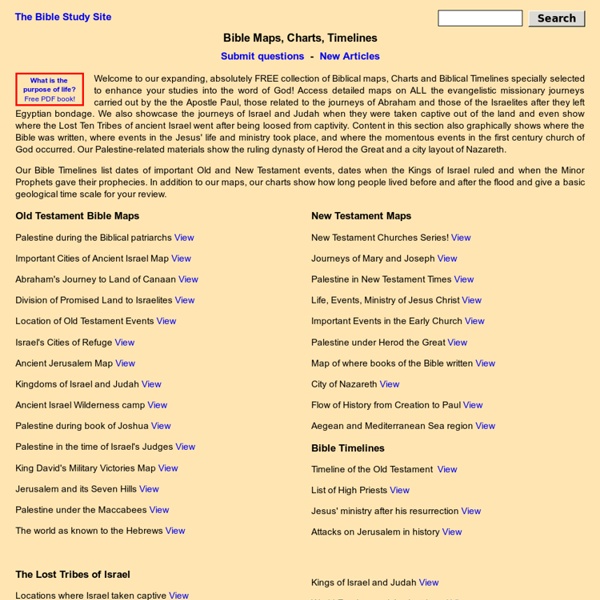Bible Maps, Timelines, Charts, Lineages

Jewish Timeline - a Brief History of the Jewish People in One Page
Bible Hub
Timeline of World History - Category:History timelines — Wikimedia Commons
Greek Mythology: FAMILY TREE OF THE GREEK GODS
The complete family tree of the gods is displayed over eight indexed charts. The basic structure follows Hesiod's Theogony, but that author's genealogies have been expanded with a plethora of additional gods, spirits and creatures sourced from other classical sources. Where there is disagreement amongst ancient writers as to the genealogy of a certain character, the oldest and/or most popular source has been selected for the chart. An additional family tree depicts the divine genealogy given in Hesiod's Theogony. Click on any name in the chart to view the full page entry for that individual. INDEX Index of names in the family tree KEY Overview of and key to reading the charts CHART 0 The Main Gods A short tree containing just the main gods of the pantheon. CHART 1 The Cosmogony of the Gods The primordial gods or protogenoi. CHART 2 The Children of Night The spirit descendants of Khaos (Air), Nyx (Night) and Eris (Strife). CHART 4 The Children of Sea, Storm and Earth.
Greek Gods Family Tree
ludios.org
Sumérien
Le sumérien (en sumérien « 𒅴𒂠 » ; translittération : EME.ĜIR15) est une langue morte qui était parlée dans l'Antiquité en Basse Mésopotamie. Elle est ainsi la langue parlée à Sumer aux IVe et IIIe millénaires av. J.-C. Le sumérien comportait deux variétés (sociolectes) connues : l'émegir et l'émesal. Le sumérien semble être la plus ancienne langue écrite connue, sous une forme d'écriture appelée le cunéiforme, voire la plus ancienne langue connue[5]. L'akkadien a progressivement remplacé le sumérien comme langue parlée autour du XXe siècle av. Terminologie[modifier | modifier le code] Redécouverte[modifier | modifier le code] La redécouverte de la langue sumérienne se produit dans le contexte de la traduction des inscriptions cunéiformes à partir de la première moitié du XIXe siècle. Reste à établir la fonction et la nature de cette langue, qui alors n'est connue que par des logogrammes dans des textes en akkadien. Sources[modifier | modifier le code] Histoire[modifier | modifier le code]
Sumerian Mythology: Introduction
Sacred Texts Ancient Near East Index Previous Next p. 1 The study of Sumerian culture introduced by the present volume, Sumerian Mythology, is to be based largely on Sumerian literary sources; it will consist of the formulation of the spiritual and religious concepts of the Sumerians, together with the reconstructed text and translation of the Sumerian literary compositions in which these concepts are revealed. It is therefore very essential that the reader have a clear picture of the nature of our source material, which consists primarily of some three thousand tablets and fragments inscribed in the Sumerian language and dated approximately 1750 B. C. a It is the first aim of the Introduction of the present volume to achieve such clarification. The decipherment of Sumerian differed from that of Accadian 3 and Egyptian in one significant detail, a detail p. 2 which proved to be one of the factors in hampering the progress of Sumerology to no inconsiderable extent. p. 3 p. 4 p. 5 p. 6 p. 7 p. 8
Sumer
Un article de Wikipédia, l'encyclopédie libre. Situation du Pays de Sumer Ayant été complètement oubliée après les débuts de notre ère, la civilisation de Sumer a été redécouverte durant la seconde moitié du XIXe siècle grâce aux fouilles de sites archéologiques du Sud mésopotamien, dont l'exploration s'est poursuivie par la suite, jusqu'à connaître un arrêt en raison des troubles politiques affectant l'Irak à partir des années 1990. En plus des redécouvertes architecturales et artistiques qui furent à plusieurs reprises remarquables, les fouilles ont permis la découverte de dizaines de milliers de tablettes inscrites en écriture cunéiforme, qui est la plus ancienne documentation écrite connue avec celle de l’Égypte antique. À la suite de l'analyse de cette documentation, cette civilisation s'est vite révélée être déterminante dans l'élaboration des civilisations antiques, en premier lieu celle de la Mésopotamie. Conditions d'étude[modifier | modifier le code] Un peuple ? ↑ J.
Related:
Related:



